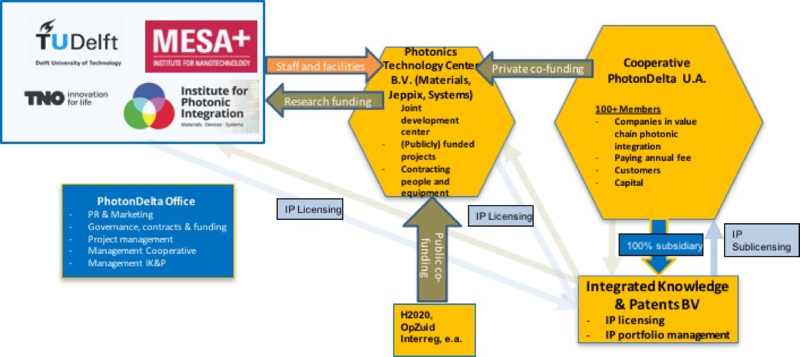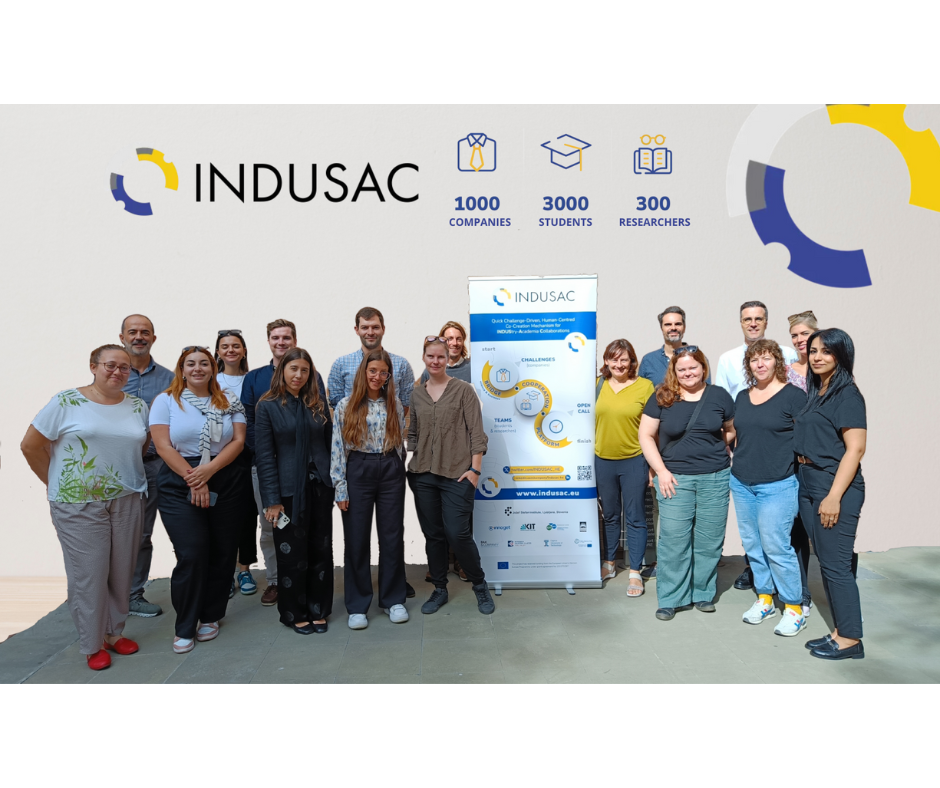PhotonDelta is a new initiative from the Technical University Eindhoven. Photonics has been acknowledged as a key technology for the future. As many of today’s chips require more and faster access to data, knowledge etc. The technology to deliver and meet these needs are lagging behind.
The aim of PhotonDelta is to build a global “end-to-end ecosystem” of researchers, chip designers, foundries, corporates, investors and soft/hardware developers. The initiative has been founded to accelerate the growing international business demand for photonics technologies. It is an open, collaborative network of trusted partners.

Sharing knowledge and IP is crucial in accelerating the research and product development in the area of photonics technologies. The model that has been selected to facilitate this is the model described above.
How the model has been applied is described below. The initiative consists over various entities collectively known as PhotonDelta. Five key entities make up the crucial structure:
- • PhotonDelta Integrated Knowledge and IP B.V.
- • PhotonDelta Institute for Photonic Integration
- • PhotonDelta Cooperative
- • PhotonDelta Technology Research Center
- • PhotonDelta Office B.V.
The research carried out in the Technology Centres will develop technologies up to Technology Readiness Level 6 in close collaboration with PhotonDelta Cooperative members, both Industry and Academia. This will ensure that the companies always have access to state-of-the-art, proven technologies and prototypes of products.
The companies in the Technology Centres will develop solid IP portfolio’s in close collaboration with other PhotonDelta companies and the Institute of Photonics Integration. PhotonDelta is organized as a collaborative community following the principles of open innovation.
PhotonDelta is a closed initiative in principle. This means that companies need to become a member of the Cooperative. Once the companies are a member of the Cooperative, they will have access to the Knowledge and IP database. This database will include pre-published data which companies outside of the Cooperative would not have access to. It may also include knowledge and insights which are traditionally not published. Pre-published data will only be accessible for 3 months and then Academics will be free to publish. This follows common arrangements made between companies and academia when collaborating.
Licenses to protectable IP will be done on a new model using license bids and standard license agreements to help lower the barriers and decrease the negotiation time.
As mentioned above, the Integrated Knowledge and IP B.V. will have a portal, which gives access to knowledge, insight, prepublications and patents. Insight in all is given on the basis of a research license. The portal to the IP and knowledge generated in PhotonDelta makes use of Innoget’s Cloud system9.
In addition to posting of new insights, knowledge and protectable IP, the Innoget Cloud system also allows for parties to post questions to the Cooperative members (anonymously) for specific knowledge, expertise, facilities or IP. This way, the Academics, too, will have a better insight into what the companies are looking for.
Success Factors / Barriers:
The basis of the model is about giving insight into research output to industry in a structured way that goes beyond the inventions and research tools offered in the classical model.
The model is aimed to:
- Lower the threshold for knowledge exchange,
- Increase collaboration between industry and academia both at a national level as well as an international level.
The long-term goals of the model include long-term partnerships between academia and industry, an enhanced quality of translational research and higher societal economic impact.
Success factors include:
- Broadening the partner base (this can be for both the institution as well as the industry sector)
- Increasing the number of research collaborations between academia and industry
Process Main Stages:
PHASE 1: SET UP
- Setting up the IP Cloud and the Industry Community.
- Training of Academics and Industry to use the system
PHASE 2: ECOSYTEM
- In the second phase, building a robust and sustainable ecosystem for Academia and Industry. For example, a closer connection or collaboration with students and the educational side.
Touchpoints & Bottlenecks:
Overcoming the current culture and expectations:
- There is little motivation for TTO’s to engage in new models. As many TTO’s are financed by the Institution. Regardless of their performance, they will survive. Adopting a new model, means their skillset needs to change a little and more focus should be given towards collaboration and partnership management. Some TTO’s have been set up as part of a (Holding) Company owned by the University. Those TTO’s will not be in favor of offering IP at a low price as they are dependent on it for their own survival. In either case, there is little motivation to change to a new model.
- Companies expect to have to pay for IP. They are suspicious when IP becomes “cheap” thinking that it is the equivalent of having no value. This is true when TTO’s combine the traditional office with Easy Access Models. Often patents are offered via the traditional route first if the TTO believes it has value. Only when no partner(s) is/are found, will it be offered via alternative routes (e.g. Durham University).
Other Potential Pitfalls:
- Imbalanced research portfolio. For an academic institution, this is vital. If the balance slides to primarily industry funding, the focus may shift too much to translational research with fundamental research decreasing.
- A second pitfall is that the research output offered on the platform may result in a jungle of output, which becomes difficult to search and find what companies are looking for.
Benchmarking and reference to other similar initiatives:
- MIT’s Industrial Liaison Program dedicated to creating and strengthening mutually beneficial relationship between MIT and corporations worldwide.
- University of Stratchclyde, Scotland, UK. However, little information can be found online.
- The Structural Genomics Consortium (SGC) in Oxford, UK
Dos and Don’ts:
DO
- Spend significant time in talking to companies and academics to explain the reasoning behind the lowered threshold to IP
- Invest time in going through different collaboration scenarios to make companies understand how the knowledge and IP sharing works, also when bringing in background IP
- Invest time in the acceptance of the IP tool and organize workshops to help academics and industry professionals use the tool efficiently.
DON'T
- Do not offer different parties different terms. If you decide to go for a standard process or fixed fee, all companies should abide. No exceptions.
- Do not give companies the right to decide who is allowed to join the Community. This may result in favoritism and will not enhance the research output and collaboration necessarily.





